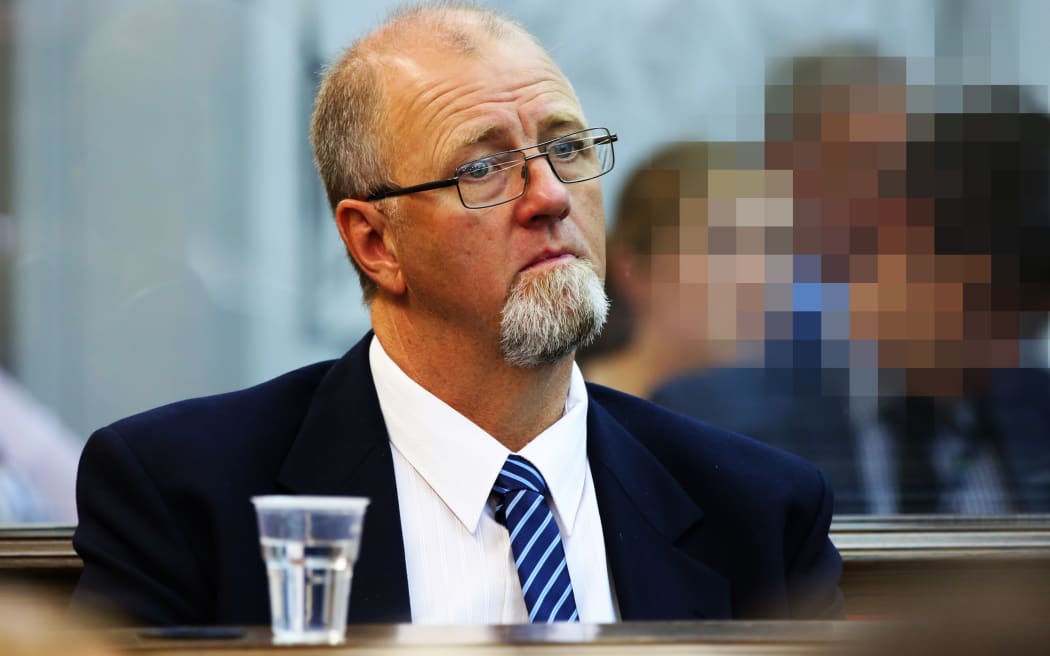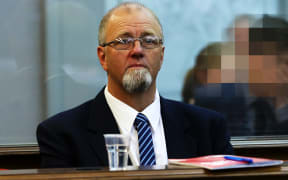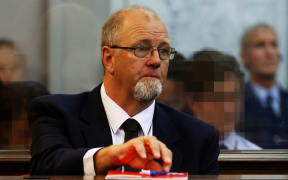The weapon used to kill Christine Lundy left a trail of blood more than three metres across the ceiling and walls of her bedroom as it was swung through the air, the High Court in Wellington has been told.

Mark Lundy at the High Court in Wellington. Photo: RNZ / Alexander Robertson
Mark Lundy, 56, is accused of murdering wife Christine, 38, and daughter Amber, whose bodies were found in their Palmerston North home on 30 August 2000.
The Crown claims he killed his wife for her insurance money and his seven-year-old daughter because she saw what he was doing to his mother.
Key points from day 13:
* Christine Lundy's blood sprayed 3m along the wall next to her bed, and on to the 2.4m high ceiling.
* Amber Lundy had blood from her mother on her body.
* No traces of semen were found around Mrs Lundy or Amber.
* Defence accuses fingerprint expert of being in and out of Lundy home "like a fiddler's elbow".
* Video previously played in court which showed someone watching TV was taken on 7 September - not the day the bodies were found.
Environmental and Scientific Research forensic scientist Bjorn Sutherland today told the court "cast-off" was a term used to describe blood "projected from a bloodstained implement as it is swung through the air".
He examined the bodies of Mrs Lundy and Amber where they were found; Amber in the doorway of her parents' bedroom and Mrs Lundy in the bed.
He described how Mrs Lundy's "cast-off" blood covered the wall behind the head up to the 2.4m high ceiling, and 3.2m along the wall next to the bed.
Mr Sutherland said Mrs Lundy had extensive head injures, as well as injuries to her arms and hands.
Mr Sutherland tested for semen around Mrs Lundy's bed but none was found, he said.
Amber was lying in a large pool of blood in the bedroom doorway, her head and shoulders protruding into the hallway, the court was told.
Blood from her mother had mingled with hers on her leg but all other blood tested from her body was her own.
Amber's blood and tissue was spattered up to 2m high and 3.8m down the hallway from where her body lay, Mr Sutherland said.
Tests found Amber's head was no more than 700mm from the ground when she was struck.
He also said blood was found on the glass and frame of a window in the conservatory, and testing found it could have come from Mrs Lundy.
Luminol testing
Mr Sutherland Luminol tested floors in the house in an effort to find footsteps but none were found.
"The absence of a trail ... can simply be due to the fact that the assailant has not stepped in the blood while leaving the scene," he said.
A Luminol test carried out on Mr Lundy's car in December highlighted several positives; Luminol is used to show blood but can also react to vegetation and vegetables.
The positives all contained human DNA but none was matched to any of the Lundys. As well, none reacted to a different chemical test generally considered to be less sensitive, Mr Sutherland said.
Two vehicles belonging to Mrs Lundy's brother, Glenn Weggery, were also Luminol tested and gave positive results but all matched him.
Blood found in his house was tested, and the results considered by another forensic scientist, he said. That scientist will give evidence later in the trial.
The scene log
Earlier today, Police National Fingerprint Office manager Eugene Wall said he arrived at the Lundy's house at 30 Karamea Crescent at 11.55am on 31 August but did not enter the property until 3.33pm - as shown by the scene log.
He did not enter the house any earlier as he was aware of the growing importance of DNA, and not contaminating the scene, he said.
However, defence lawyer David Hislop, QC, said the scene log then showed him leaving the scene, then coming back, then leaving and coming back again.
"This is you in and out, basically like a fiddler's elbow, isn't it," Mr Hislop said.
One of Mr Wall's main tasks was to examine Mr Lundy's car and the house with a specialist tool known as a Polilight - a tool Mr Hislop said had since been shown to be a "veritable source of contamination" before asking whether he was so adamant he had not entered the house.
"All my years of working in fingerprint and going to crime scenes, you get used to waiting around.
"What I am absolutely certain of, because of my consciousness about DNA, was the first thing I examined using the Polilight was the car," Mr Wall said.
Timing of video
Detective Senior Sergeant Nigel Hughes, who was in charge of control and security at the Lundy home, has already given evidence at the trial in the High Court in Wellington but was today recalled to clarify the timing of a video the defence showed earlier this week.
Mr Hughes said he had been "misled" on Monday into thinking the video was taken the day the bodies were found and was part of the scene video.
It was, in fact, a clip of a video taken by Terralink on 7 September in order to reproduce a scale diagram of the house.
Mr Hislop on Monday pointed out someone in the video who appeared to be watching TV, and who was not wearing full protective gear.
Mr Hughes today identified himself as the person watching TV but said he was simply checking it as part of his scene examination, just as he had checked the fridge, freezer and pantry.
Mr Hislop disputed that: "You were sitting there watching the news. You weren't testing the TV to see if it worked," he said.
But Mr Hughes remained adamant he was not watching the news, and said he was not in protective gear as the bulk of the examination had been completed by then.
* Clarification - For the avoidance of doubt, please note that Radio New Zealand reporter Sharon Lundy is no relation to Mark Lundy.





